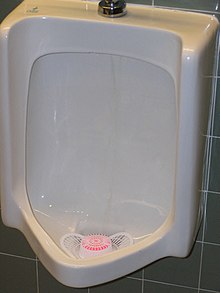Toilet stone
With toilet block , Beckstein , urinary stone , pee stone , Klostein or toilet block slowly dissolving agent concentrates are referred to in toilets and urinals are intended to keep odors low. They should also contribute to hygiene , even in places that are mechanically inaccessible. Furthermore, they should prevent limescale deposits on the ceramic. Kurt Gade applied for a patent for the Klostein in 1963 .
The annual turnover of toilet stones and gels in Germany is around 100 million euros.
Liquid products
Systems have also been on the market since 2001 in which cleaning and fragrance substances are released in small quantities from two separate chambers during each rinsing process.
Chemical composition
A toilet block consists of a water-soluble carrier substance and anionic surfactants (15–30%) as well as a small amount of nonionic surfactants (1–5%), hydrogen peroxide and synthetic fragrances and dyes . According to the Öko-Test magazine, around a third of the products contain artificial musk compounds and organic halogen compounds . Both are harmful to the environment. Another substance in toilet blocks is the strong-smelling paradichlorobenzene . It arises as a waste product in the chemical industry. The liquid products are free from polycyclic musk compounds and organohalogen compounds.
criticism
Toilet stones can simulate good hygiene in toilets that are actually poorly cleaned. However, a clean toilet does not give rise to unpleasant odors. The ingredients can pollute the wastewater and have already been detected in fish and also in breast milk . In addition, strongly smelling cloister stones can irritate the mucous membranes . Environmental protection organizations therefore advise not to use cloisters.
Individual evidence
- ↑ The unnecessary product in February: cleaning agents for the bathroom and toilet ( memento from January 14, 2013 in the web archive archive.today ), accessed on April 23, 2014.

